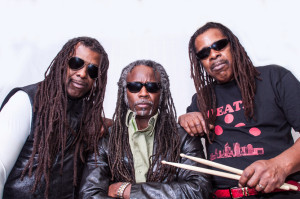Such went the call from the opening band, referring to the headliners.
That it would come out as such a sobering question of mortality may have been one of the reasons the band named Death never became the stars they might have 40 years ago.
The sound of Death (not to be confused with the ‘80s Orlando metal band with the same uncommercial name) predated the Black Rock Coalition by a decade but the trio of Detroit brothers conjured up a hard rock sound of bluntness and soul. From the town of MC5 and Iggy and the Stooges, here was a straight ahead band playing the kind of rock Hendrix was hinting at in the Band of Gypsies five years earlier — a Detroit sound quite different from that that came from Motown, which had only recently fled to Los Angeles.
Still, the brothers Hackney — particularly its guitarist David — refused to compromise on the name. Record companies had contracts ready for them if only they’d change it. But they were adamant on keeping the name.
So aside from a couple of local singles that now fetch hundreds of dollars, the band went unknown until Drag City looked them up, acquired the master tapes, and issued an album in 2008 that held up quite well to a new generation. There followed one of those movies, about another long lost act making a comeback, in the tradition of “Searching for Sugar Man” (about another Detroit active about the same time, Sixto Rodriguez, who was unaware of his legions of fans in South Africa) or the one about the obscure metal band “Anvil! The Story of Anvil.”
“A Band Called Death” came out in 2013 and its director is still connected to the band; he introduced the show Saturday at the Black Cat in Washington, D.C., an event significant enough to give the film a new, upbeat ending.
A blurb about Death and a copy of one of its rare singles is one of the more obscure things among the objects in the flashy Musical Crossroads exhibit of the Smithsonian’s newly opened National Museum of African American History and Culture. Amid artifacts from Chuck Berry to Chuck D, from Little Richard to Lil’ Wayne, here was this oddball single and odder story — of one of the earliest punk bands, from a trio of generally unknown black brothers.
I took note of the name, one of a few that didn’t ring a bell, at a museum press preview a week and a half ago; I looked up their stuff online and made some mental notes. But I was floored to learn that the band itself would be playing the venerable Black Cat the same weekend that the museum was opening.
So on a day when Stevie Wonder and Denyce Graves sang at the ribbon-cutting; where Public Enemy and The Roots were playing a big outdoor festival, and Parliament/Funkadelic was headlining a few blocks away at the 930 Club, here was Death, clearly moved by their own part in the proceedings.
“From now on, a little piece of us will always be part of Washington, D.C.,” founding bassist Bobby Hackney, resplendent in his paisley waistcoat, marveled.
With brother Dannis Hackney slamming away on drums (and including a solo at one point), Bobbie Duncan adds guitar play that can be as light as a Curtis Mayfield or thudding as the heaviness they portended.
Duncan stepped in for David Hackney after the guitarist’s death in 2000, following a bout with alcoholism. At that time, nobody had mentioned the band Death in decades. The three brothers had moved from Detroit to Vermont, of all places, to start a gospel rock band called 4th Movement and then a reggae band called Lambsbread. Interest in their rock years nudged them to reassemble Death. Two additional LPs followed, including one with their newest material in decades. In D.C., getting used to creating history, they played two new songs for the first time.
The first, “Cease Fire,” harkened back to the Band of Gypsies “Machine Gun”; on the other, “Give It Back,” Bobby Hackney showed a soulful vocal prowess that echoed Rick James. More often, he’d use a clipped, robotic, lower voice to animate the driving songs. Musically, the back-to-basics approach were sometimes more reminiscent of other Michigan bands like Grand Funk or Rare Earth. But they had an authenticity and ease that had them soaring above such mortals.
They played most of their 2008 comeback “…For the Whole World to See” from “Keep on Knocking” and “Rock-N-Roll Victim” to “You’re a Prisoner.” But was something just right about hearing “Politicians in My Eyes” right in the nation’s capitol.
There’s an undeniable, freewheeling punk sound to the band that returned with the encore “Can You Give Me a Thrill???” and the enthusiastic crowd rocked along with them.
Death itself, on such a high to have been included in the Smithsonian’s newest museum, were pumped to be back in D.C., where they played the Black Cat last year, and excited about an impending European tour. And they dispatched their vivid music succinctly, not overstaying their set with as much virtuosity as possible within their simple, blunt songs.
That the opening band Rough Francis, were also from Vermont made one rethink one’s pre-existing impressions of the number of African-Americans in the Green Mountain state, let alone black rockers there.
But when they said “we’re the sons of Death,” they weren’t speaking metaphorically.
Sure, they had obviously been influenced by the ’70s band and their sound. But apparently three of the band members are also literal sons of Bobby Hackney, brothers who formed their quintet in 2008 to play the Death songs just getting wider distribution on Drag City. Even as they’re enshrined in a museum, Death is spreading. Y’all ready?
